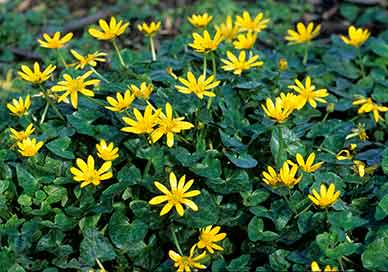Lesser celandine (Ranunculus ficaria)
When: Late February - May
How many: Thinly distributed

Small numbers of lesser celandines come into bloom in February, but most wait until the ground warms a little more in March or April. But all dash for growth before the trees unfurl their leaves, flowering early in the short period between growing conditions returning after winter, and the canopy shading out all below.
At first glance, lesser celandines are easily confused with the closely related marsh marigold. Both have dark green, heart-shaped leaves and yellow flowers, whilst in the past, both were also known as kingcups. But there the similarity ends, for close examination reveals lesser celandines as smaller, daintier plants; with more, pointed petals; and a liking for drier ground.
One writer, W.T. Fernie in Herbal Simples Approved for Modern uses of Cure, published in the late-19th century, said of the lesser celandine: ‘It bespangles all our banks with its brilliant, glossy, golden stars,’ and this accurate observation reflects another local name – the earth star.
As befits such early flowering plants, lesser celandines have evolved a clever strategy to survive what is often unpredictable early-spring weather; for as darkness falls and on dull, drizzly days, the flowers close tightly shut, protecting the precious nectar and pollen from the cold and damp.
William Wordsworth noticed this, and devoted a poem to the lesser celandine. It starts:
There is a flower, the Lesser Celandine
That shrinks, like many more, from cold and rain
And, the first moment that the sun may shine
Bright as the sun himself, ‘tis out again!
Wordsworth, then, admired the lesser celandine, and so, too, do New Forest commoners’ stock, and deer, which feed avidly on the plants, significantly reducing both numbers and vigour. However, some plants survive as all-too-often weak, straggling specimens, unlike elsewhere in Hampshire where they are often widespread and abundant.
As with many of our native plants, lesser celandines were once commonly used as curatives for all manner of ailments. Small, oval underground lesser celandine root tubers, for example, found favour for the relief of even the most painful haemorroids, and gave the plant another distinctive local name: pilewort!
But even more unusually, beggars apparently used the lesser celandine's acrid juices to induce sores designed to arouse maximum sympathy from passers-by.
References:
The Wild Flowers of Britain and Northern Europe: Richard Fitter, Alastair Fitter and Marjorie Blamey
Reader’s Digest Field Guide to the Wild Flowers of Britain
Herbal Simples Approved for Modern uses of Cure: W.T. Fernie
The Englishman’s Flora: Geoffrey Grigson
More links
Other related links
Search this site

Sadly, 58 animals were killed - 35 ponies, 13 cows, 8 donkeys and 2 sheep, whilst a further 32 were injured - 3 pigs, 9 donkeys, 11 cows and 9 ponies.
(Forty-three accidents occurred in daylight, 15 at twilight and 101 in the dark. Twenty-seven accidents were not reported by the driver involved).
Here's just one horrific example - Three donkeys killed in collision with van at notorious New Forest blackspot (Advertiser and Times)

